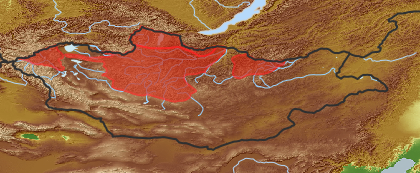| Class: | angiosperms |
| Order: | Lamiales |
| Family: | Lentibulariaceae |
| Genus: | Utricularia |
| Scientific name: | Utricularia intermedia Hayne |
| Name acc. to: | Gubanov 1996 |
| Herbar: | list records  |
| Description: | Trap bladders located on special colorless branchlets with rudimentary leaves, green leaves without bladders arranged in two lines on stem. |
| Confuse with: | Species to recognise by bearing bladders on special branchlets. |
| Link to Flora of China: | http://www.efloras.org/browse.aspx?flora_id=2&name_str=Utricularia+intermedia |
| open map in a new window |  |
| Habitat: | Shallow waters of lakes, old river beds, backwaters (Grubov 2001). |
| Habit (i)general appearance of a plant | |
| Growth form: (i)Herb, shrub, tree or climber. | herb (i)Herbaceous, erect plant, up to 2m high, mostly with a leafy shoot; if perennial, shoots die to the ground each season, shoots are not woody
example: Artemisia pectinata 
perennial (i)Living for several to many years, as opposed to annual and biennial
acc. to: FoC online |
| Parasite status: (i)Is the plant a half- or full parasite? | no parasite/saprophyte (i)Plant fully autonomous, leaves with chlorophyll
example: Most plants, Ranunculus  inherited by family Lentibulariaceae: no parasite/saprophyte inherited by family Lentibulariaceae: no parasite/saprophyte
|
| Water or terrestrial plant: (i)Where do the plants grow? | water or swamp plant  inherited by family Lentibulariaceae: water or swamp plant inherited by family Lentibulariaceae: water or swamp plant
|
| Leaf (i)expanded, usually photosynthetic organ of a plant (including phylloclades) | |
| Leaf veination: (i)Arrangement of the main veins of a leaf. | pinnate (i)One main vein, several side veins, sometimes inconspicuous
example: Cicerbita     inherited by family Lentibulariaceae: pinnate inherited by family Lentibulariaceae: pinnate
|
| Root / shoot below ground (i)plant part below ground (in most cases), including below ground shoots, without leaves | |
| Root type: (i)Organisation of the roots. | allorhizous (i)Plant with a conspicuous tap root, one larger tap root with side roots
example: Dicotyledonae  inherited by order Lamiales: allorhizous inherited by order Lamiales: allorhizous
|
| Distribution (i)region where the plant is likely to be found | |
| Distribution (Veg. Zones): (i)acc. to Grubov 1952 | Khubsgul (i)In distribution data often named as '1' 
Khentei (i)In distribution data often named as '2' 
Khangai (i)In distribution data often named as '3' 
Khobdo (i)In distribution data often named as '6' 
acc. to: Gubanov 1996 |
| Distribution Khangay: (i)acc. Flora Khangaya 1989 | I
IV
V
|